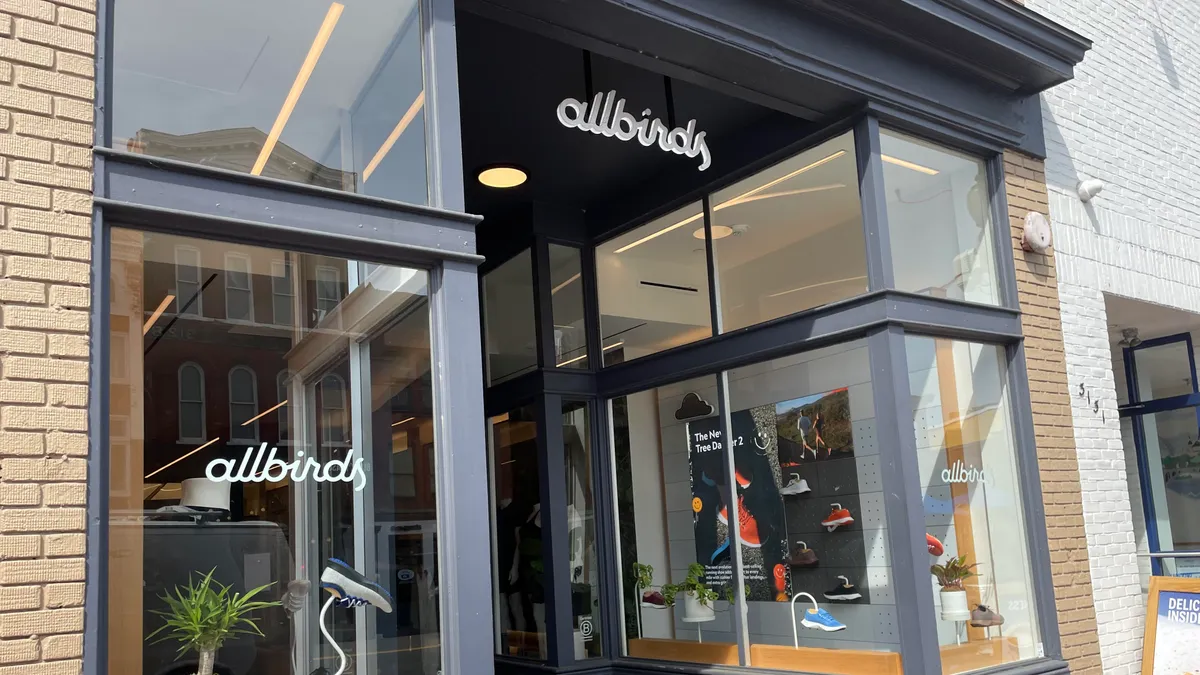Dive Brief:
- Alongside a nearly 15% revenue drop for 2023, Allbirds on Tuesday named a new CEO, replacing co-founder Joey Zwillinger. Joe Vernachio, who has been Allbirds’ chief operating officer since 2021, will take over the top post and join the board of directors on Friday.
- Zwillinger will stay on as a board member and a special adviser to the company, according to a company press release. Allbirds co-founder Tim Brown stepped down from the co-CEO role last year and now serves as the brand’s chief innovation officer.
- At the same time, Allbirds reported earnings, with revenue for Q4 and the full year both down by about 15%. Fourth-quarter revenue was $72 million, while full-year revenue was $254 million. The brand plans to close 10 to 15 underperforming stores in the U.S. in 2024 and is projecting revenue this year to be down as much as 25% year over year, per the announcement.
Dive Insight:
With its revenue in freefall, Allbirds is looking to a new leader to turn things around.
Allbirds’ Lead Independent Director Dick Boyce thanked Zwillinger for his “enormous contributions” in an announcement, but said the company is “delighted” for Vernachio to take over. Allbirds said COO Vernachio has been “instrumental” in the company’s transformation plan so far, including efforts to reduce inventory, improve U.S. distribution and transition to a distributor model in international markets. The company granted Vernachio additional responsibilities last year, including oversight of commercial and international functions, and said he has since also taken control of product development.
Vernachio comes with four years of experience as president of Mountain Hardwear, as well as seven years as vice president of global product at The North Face, and leadership experience from the likes of Patagonia, Nike and Calvin Klein. Allbirds noted in the release that the executive previously led Mountain Hardwear through “declining sales and losses to robust growth and profitability.”
“Joe’s expertise has been particularly meaningful as we’ve worked to align our ethos with operational and financial execution … I have every confidence that we have built the foundation for an enduring, multi-generation brand that will thrive in the years to come,” Zwillinger said in a statement.
Whether that vision comes to fruition or not, Allbirds is not thriving yet. Losses continued to mount in the fourth quarter, with net loss surging 128% to $57 million, while that metric grew 50% for the year, hitting $152 million. For the year ahead, the footwear brand is projecting net revenue of $190 million to $210 million in 2024, down 17% in the best-case scenario, and an adjusted EBITDA loss of $63 million to $78 million. Chief Financial Officer Annie Mitchell said the brand plans to return to top-line growth in 2025 and profitability in a few years.
In addition to improving financials, a new CEO is also an opportunity to correct what GlobalData Managing Director Neil Saunders called Allbirds’ “broken proposition” of focusing on sustainability.
“Allbirds has pushed the sustainability message because it is a passion of its founder. That’s fine, but the passions of individuals are not selling strengths if they are misaligned with the market,” Saunders said in emailed comments. “We believe that Vernachio will be able to guide the company in a way that is focused on consumers and is dispassionate about internal beliefs and viewpoints. However, as good as a fresh hand at the tiller is, Vernachio has a lot of steering to do to get Allbirds back on the right track.”
On the chopping block as Allbirds looks to turn things around are a group of underperforming stores, some of which are newer locations, Zwillinger said on a call with analysts. Those newer stores had a larger square footage to account for a broader apparel assortment that Allbirds has since pared down. The company’s current plan to close 10 to 15 stores — about 17% to 25% of its 60-store fleet — will cost its U.S. business about $7 million to $9 million.
“Stores remain a highly effective way to meet new customers and drive omnichannel purchasing and omnichannel purchasing is the most profitable consumer journey we can generate,” Zwillinger said. “As we focus on renewing brand momentum and driving sustained growth in the U.S., we are leaning into our most efficient stores in key cities where we want to win.”
International revenue will also be hit with $25 million to $28 million in costs as Allbirds moves from a straight DTC model to a distributor model. Zwillinger on a call with analysts said the distributor model is a “more profitable” go-to-market strategy and is allowing Allbirds to consider entering more international markets going forward. The company moved Canada and South Korea to a distributor model in 2023, and announced agreements covering Australia and Japan this month.
Vernachio outlined his own priorities on the call as well, which include improving the assortment with a focus on iconic products and seasonal collections (a refreshed product line is set to launch in late Q2); producing more clear and connected brand messaging; expanding international through distributors; and developing a robust U.S. marketplace by building wholesale and optimizing DTC channels.
Allbirds has been shaking up its leadership team more broadly over the past year or so, naming a new CFO a year ago, and appointing a new chief marketing officer and a chief design officer in January. The retailer also underwent layoffs in May last year, eliminating 21 employees globally.
“Allbirds will need to take quite a few steps back before it can move forward,” Saunders said. “The only short term relief will come from the brand finding a buyer willing to snap it up.”














